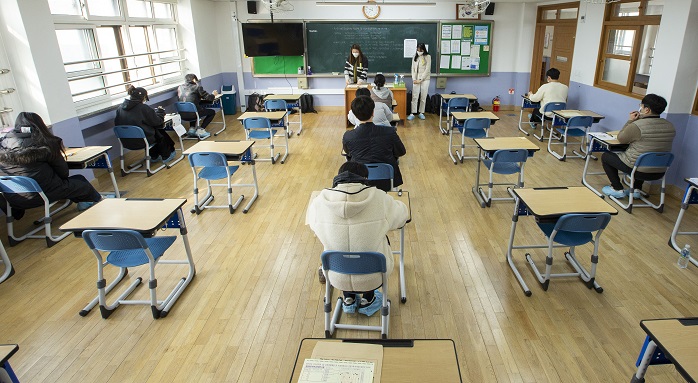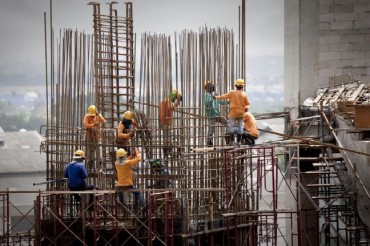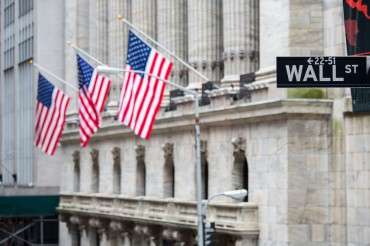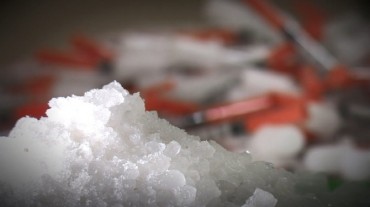
A recruitment test for public servants is under way at a school in the central city of Daejeon on March 6, 2021, with applicants sitting apart to prevent coronavirus infections, in this photo provided by the Ministry of Personnel Management.
SEOUL, March 6 (Korea Bizwire) — South Korea’s daily new coronavirus cases hovered above 400 on Saturday as sporadic cluster infections showed no signs of a letup and the rising number of travelers amid warm weather could spark yet another uptick.
The country reported 418 more COVID-19 cases, including 404 local infections, raising the total caseload to 92,055, the Korea Disease Control and Prevention Agency (KDCA) said.
The daily case was slightly up from 398 reported on Friday, but down from 424 tallied on Thursday.
The country added five more deaths from COVID-19, raising the total to 1,632. The fatality rate was 1.77 percent.
South Korea reported record-high daily infections of 1,241 on Christmas last year, with the figure gradually falling since with some ups and downs.
The number, however, has stayed stagnant recently at around 300 and 400, as cluster infections from workplaces and hospitals have lingered.
Health authorities and regional governments reported 379 additional cases as of 9 p.m. Saturday, down from 389 at the same time on Friday. The rolling seven-day average is 391.
There are typically fewer tests done on weekends. Daily tallies are counted until midnight and announced the following morning.
Authorities are vigilant as more South Koreans are expected to enjoy outdoor activities in the warmer weather, warning that people should continue to stay home to flatten the virus curve.
The greater Seoul area, home to about half of the nation’s 52 million population, is currently under the Level 2 social distancing scheme, the third highest in its five-tier system, and other regions are placed under Level 1.5.
Private gatherings of five or more people are banned nationwide.
South Korea, meanwhile, has tentatively decided to adopt a four-tier social distancing system that allows merchants, such as cafes and restaurants, to do business under voluntary containment efforts.
Health authorities plan to finalize the new social distancing scheme by the end of the month.
The country has administered vaccinations to a total of 296,380 people since launching a mass vaccination campaign last week, with an additional 67,840 getting the shots Friday, according to the KDCA.
AstraZeneca’s vaccine accounted for 291,131, while Pfizer’s took up 5,249.
The figure amounts to 0.57 percent of the nation’s total population.
South Korea aims to achieve herd immunity by November.

A transport aircraft of the Air Force carrying COVID-19 vaccines takes off from Seoul Air Base in Seongnam, south of Seoul, on March 5, 2021, to head to Jeju airport on South Korea’s largest island of the same name. (Yonhap)
The number of people suffering adverse effects after receiving jabs came to 2,883 so far, up 1,305 from the previous day. The majority of them showed common and mild symptoms such as headache or fever.
The number of people who have died after receiving the jabs came to seven so far, although their correlation has not been proven.
“Despite the full-fledged launch of the vaccination program, it will still take a considerable amount of time to achieve herd immunity,” an official from the KDCA said. “With daily figures hovering around 400, a resurgence can happen at any time.”
Authorities, meanwhile, fines of under 2 million won (US$1,771) will be issued for those who receive shots by cutting in line of the scheduled vaccination plan.
Of the 404 locally transmitted cases announced early Friday, 126 additional cases were reported in Seoul and 172 in Gyeonggi Province that surrounds the capital. Incheon, 40 kilometers west of Seoul, identified 19 new cases.
The three areas account for around half of the nation’s 52 million population.
North Chungcheong Province reported 22 infections, and the southeastern port city of Busan added 12.
Infections linked to a box manufacturing line from Icheon, south of Seoul, reached 41, up two from the previous day.
Cases tied to a glass manufacturing factory in North Chungcheong Province came to 17.
The number of foreigners who have tested positive in Dongducheon, north of Seoul, reached 132, according to the official KDCA data. More investigations are in progress for their families and people who came into contact with them.
Over the past two weeks, cluster infections accounted for 32 percent of new cases, while the transmission routes of 23 percent of cases remain unknown.
There were an additional 14 imported cases, raising the total caseload to 7,160.
Of the newly added imported cases, patients from the United Arab Emirates accounted for three, while arrivals from the United States and Pakistan each took up two.
South Korea currently requires all arrivals to hand in polymerase chain reaction (PCR) test results. Foreigners without proper documents are denied entry.
The number of seriously or critically ill COVID-19 patients was 136, up one from the previous day.
The total number of people released from quarantine after making full recoveries was 82,913, up 353 from a day earlier. More than 90 percent of the patients reported here have been cured.
South Korea has carried out 6,821,943 COVID-19 tests so far, including 32,932 from the previous day.
(Yonhap)






